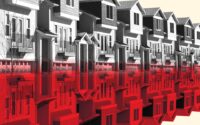China Shifts to Stimulus Mode With Xi’s Options Dwindling
(Bloomberg) — China is ramping up policy stimulus to boost its faltering economy, although soaring debt levels and concerns about financial stability mean the measures are likely to be limited compared with support packages in previous downturns.
Most Read from Bloomberg
The People’s Bank of China unexpectedly cut a series of different policy interest rates on Tuesday, paving the way to lower the key lending rate which will be announced on Thursday. After reducing a key short term interest rate that heavily influences interbank liquidity early on Tuesday, the central bank then cut the higher rates which are seen as the ceiling of the corridor, adding to expectations of more easing.
In addition to these monetary policy actions, officials are considering a broad package of stimulus proposals, which include support for areas such as real estate and domestic demand, according to people familiar with the matter.
The moves suggest a shift in stance by President Xi Jinping’s government from its cautious approach to stimulus, underscoring policymakers’ concerns about the economy’s slowdown after a consumer-led surge early in the year started to peter out. But the impact of any stimulus — and the government’s room for maneuver — are likely to be limited by already stretched balance sheets among local governments and the real estate sector.
“The room for traditional stimulus tools is increasingly small, and they have led to lingering negative impact in the past, including high local government debt, inefficient investment and resources being wasted,” said Lu Ting, chief China economist at Nomura Holdings Inc. China’s high debt ratio means “it will be more difficult to roll out a support policy package,” he said.
Financial markets were relatively muted after the cut Tuesday morning, suggesting mounting skepticism that monetary policy alone can fix the economy’s ailments. Business and consumer confidence remains weak, households are reluctant to borrow, inflation is near zero and exports are contracting as the global economy slows.
“Everyone from the public to policymakers in Beijing has realized that the economic recovery is facing grave pressure now,” Lu said. “The risk of an economic double-dip is rising. Cutting interest rates alone won’t be enough.”
A gauge of property developers’ shares rose less than 1% following the news. The CSI 300 Index edged up 0.5% on Tuesday, and the domestic stock market has languished in a bear market for close to one and a half years.
Even so, economists are betting the PBOC will ease monetary policy further this year. Goldman Sachs Group Inc. predicts a 25 basis-point cut to the reserve requirement ratio for lenders — which will free up more money for banks to boost lending — in the third quarter. That could be followed by another RRR move or interest rate cut in the fourth quarter, depending on the economy’s performance, according to the bank’s economists.
Rate Corridor
The seven-day repurchase rate is the rate banks can receive for lending reserves to the central bank and was cut by 10 basis points to 1.9% Tuesday morning. That rate heavily influences the rate at which banks lend central bank reserves to each other.
The standing lending facility rate is the rate at which commercial banks can borrow reserves from the central bank, and the one-month rate was lowered to 3.25% on Tuesday evening Beijing time. The idea is that bank’s won’t want borrow from each other at a higher rate than the central bank offers, so it sets a ceiling on interbank rates.
Macquarie Group Ltd. expects a 10 basis-point cut in the PBOC’s one-year medium term lending facility rate in the third quarter after a reduction later this week.
What Bloomberg Economics Says…
Our SHOK model suggests that a 10-bp cut to the key MLF rate would have only a modest impact on growth, lifting it by just 0.1 percentage point in 2023. This implies that more stimulus will eventually be needed, although it is probably true that even a small trim will help boost confidence because of its signaling effect.
For the full report, click here
David Qu, China economist
The new stimulus package under consideration has been drafted by multiple government agencies and includes at least a dozen measures designed to support areas such as real estate and domestic demand, according to people familiar with the matter.
A key component is support for the real estate market. Regulators are seeking to lower costs on outstanding residential mortgages and boosting relending through the nation’s policy banks to ensure homes are delivered, one of the people said.
The State Council may discuss the policies as soon as this Friday but it’s unclear when they will be announced or implemented, the people said.
“The aim of stimulus this time is to keep growth ticking over, consistent with the relatively conservative ‘about 5%’ gross domestic product growth goal, rather than to spur a round of robust growth,” said Duncan Wrigley, chief China economist at Pantheon Macroeconomics. “Policymakers are still wary of repeating the kind of debt hangover that the Global Financial Crisis stimulus produced and they spent the decade up to the pandemic trying to sort out.”
Property Woes
The weak property market remains a major drag on China’s economy, although policymakers appear reluctant to use its old playbook of driving up investment in real estate as a way to boost growth. Goldman analysts said in a recent report they don’t expect a repeat of the 2015-2018 shantytown renovation program that pumped central bank money into the property sector and sent home price surging.
Beijing is seeking to reduce the economic and fiscal reliance on the housing market, Goldman said, which suggests an L-shaped recovery in coming years.
Wrigley said authorities could allow cities to offer lower down payments, guide mortgage rates lower and partly roll back home purchase restrictions. Central bank-funded financing support for smaller cities, similar to the shantytown project, can’t be ruled out, but will likely be on a smaller scale, he said.
PBOC Governor Yi Gang last week hinted at more policy flexibility, vowing to step up “counter-cyclical adjustments” — a shift in language that some analysts said signaled more easing. He also pledged to “make all efforts to support the real economy” as the recovery in demand has lagged that of supply.
The timing of the central bank’s rate cuts may have also been motivated by the US Federal Reserve’s policy decision this week. The Fed is likely to pause its rate hikes, which would help ease pressure on the yuan. The Chinese currency has weakened 3.6% against the dollar this year, making it one of the worst performing Asian currencies.
Larry Hu, head of China economics at Macquarie, said Tuesday’s rate cut signals Beijing’s stance is turning more supportive, and various policy steps will be taken in the same direction.
“Policy is the only game changer” in the face of weak consumer and business confidence in the economy, Hu said. “The rate cut today sent a clear signal that policy would turn more supportive in the coming months, a significant shift from the tapering in stimulus since April.”
–With assistance from Jun Luo and Fran Wang.
(Updates with new rate cuts by the central bank from second paragraph.)
Most Read from Bloomberg Businessweek
©2023 Bloomberg L.P.
[ad_2]
Source link


